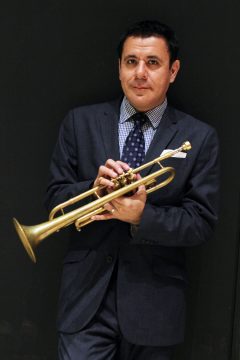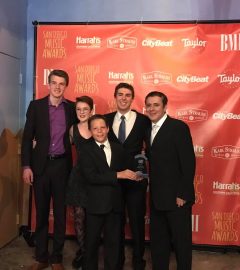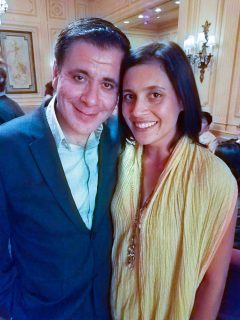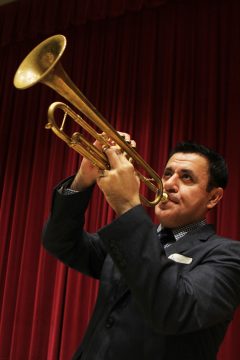Cover Story
GILBERT CASTELLANOS: Man on a Mission
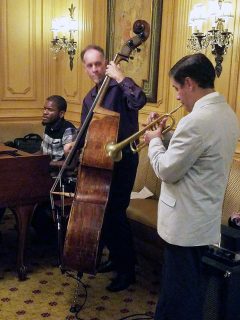
Castellanos at his regular Friday night gig at the Westgate Hotel with Joshua White and Rob Thorsen.
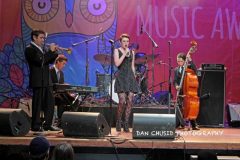
Zion Dyson sings at the San Diego Music Awards with Gilbert and the Young Lions. Photo by Dan Chusid.
Catching up with Gilbert Castellanos can require inside connections, a little mojo, and a dash of good fortune. The San Diego trumpet virtuoso and music educator is always working.
Each morning begins with a commitment to the horn. “I try to get up by seven,” says Castellanos. “I’ve been doing this for years. I’ll practice for two hours before I have coffee or food. That’s just warming up–not even playing music–just buzzing the mouthpiece or playing long tones. Then I have a light breakfast and check my emails and texts for maybe an hour. Then another two hours of practice and I’ll take a break. I might have a few students, and I always have to budget extra time there, because I always go over. I have so much fun with my students that the lessons always run long, and I’m sure they love that. After that, I may practice another couple of hours, I try to average five to six hours a day, and that doesn’t include teaching and working a gig.”
That work ethic has made Castellanos a six-time San Diego Music Award winner including a 2013 “Best Artist” (the only time a jazz artist has been awarded that honor), earned him a 2017 Jazz Journalists “Jazz Hero” award, as well as a Downbeat magazine “25 for the Future” designation (wedged nicely between fellow innovative trumpeters Christian Scott and Ambrose Akinmusire) ten years ago. He is the most powerful and ubiquitous force in the San Diego jazz community–a community he has unified through countless hours of tireless work.
He’s just good for the city, because he involves himself. He’s always looking for ways to expose jazz to a larger audience and, in particular, the youth. That’s admirable because everyone doesn’t have a gift for doing that, or even wanting to. He wants to get involved. He’s smart and dynamic and, on top of all that, he’s a wonderful player.
–Bebop legend Charles McPherson
The Early Years of a Reluctant Virtuoso
Castellanos was born in Guadalajara, Jalisco, Mexico, in 1972, right in the shadow of a huge soccer stadium. His parents came to Los Angeles, then Fresno, where they bought a home. Music was always around the house, as the elder Castellanos was a busy bandleader in his own right.
But Gilbert remembers the influence of the feminine mystique as primary. “Well, I grew up around a lot of women. I have no brothers; I have a lot of sisters. I was the chosen one from my father’s perspective to be a musician, because my sisters wanted nothing to do with it. He got us all started on piano with a teacher, but I was the only one to stick with it. One day in his room I found a trumpet and picked it up.”
The instrument, however, was not a “love-at-first-blow” relationship. “I hated the trumpet,” Castellanos recalls. “My father forced me to play it. I had no childhood, I couldn’t go out and play with my friends, I had to practice three to four hours every day before I could go out and do anything. He was very strict–we had to do our homework every Sunday. He would even make us choose a subject every week from the Fresno Bee and write a five or six page article about it. He was a real stickler for education.”
The elder Castellanos made sure Gilbert got early trumpet training from the members of his band. “He had two trumpeters. One was a classical guy and the other was a jazz, Latin, jack-of-all-trades guy. He had me studying with both of them when I was six or seven years old.”
Even though he wasn’t thrilled to have the instrument thrust upon him at such an early age–Gilbert was inexorably drawn to his dad’s large record collection–which would have a lasting impact. “He was a big jazz fan. He had a huge record collection, and he was always working, so I started listening to his records on the sly. He had Duke Ellington and Count Basie and Benny Goodman. One day I found a Freddie Hubbard album (Red Clay) that changed my life. I actually made a little cassette copy of it. I should point out that I would always put his records back exactly the way I found them because I didn’t want my father to know that I had been listening. But Red Clay I had to have with me, so I would play the cassette every night under my pillow. I must have listened to it a thousand times. And that’s when the light turned on and I thought, ‘I’m going to try to learn to play like this!’”
From that moment on, the trumpet and jazz music became the prime directive in Gilbert’s young life.
He even talked his junior high school teacher into starting a big band. “I had a big-time crush on her, and here I was, this little seventh grader, convincing his teacher to start a big band, and she did it!”
The Fresno Jazz Scene
One might not assume that Fresno was a musical metropolis, but Castellanos is quick to point out evidence of a thriving culture. “Let me say this: there were some incredible musicians that were living in Fresno; there were quite a few venues as well. Plus Fresno State brought tons of people in. That’s where I met Clark Terry and Dizzy Gillespie and Maynard Ferguson.”
Two local musicians impacted Gilbert’s life forever. “Loren Pickford and Don Weed had a gig at a place called Butterfield’s. They were incredible players–Don used to play with Chet Baker back in the day. Those two gentlemen were like angels. They took me under their wing.”
But first, Gilbert had some learning to do. “I would bring my trumpet, and the bass player, who was in his eighties at the time, asked me what standards I wanted to play. I didn’t even know what that meant, I’m 14 years old and this is way before the internet, so I went and asked my teacher and he kind of broke it down as being songs from the Great American Songbook. So I learned ‘All the Things You Are,’ and went back to the Butterfield. The bass player said they weren’t going to play it in the key I had learned. He told me to go back and learn it in all 12 keys, and I’m still working on that! But when I finally went back, they let me play and I started learning more and more tunes, and I started to get a taste of what it’s like to be a professional musician. By the time I was a sophomore in high school, I was getting paid $60 a night to play with them.”
The Trumpet as a Ticket Out of Fresno
“At this point I started to really buckle down and practice the instrument religiously, because I knew that the horn was already bringing attention to me in high school. People were coming out to hear me play on Friday and Saturday nights.
“This famous trombone player from L.A., Phil Ranelin, came to Butterfield’s one night and he told me there was nobody my age in L.A. that could play like me. That kind of put the bug in my ear–I knew I must be doing something right. Those words of encouragement meant a lot to me at the time and I knew I had to keep my focus on playing music and improving.”
By then, Gilbert was attracting a lot of attention at jazz festivals all over the world. “I started to win scholarship money from the Berklee School of Music in Boston. At the end of these festivals, they would give out awards. One time I got $500, the next time $1000, and eventually I got $10,000. At that point they offered a full scholarship.
“I wish I had proof of this, but to this day I strongly believe that Dizzy Gillespie was responsible for me getting that scholarship to Berklee. He knew everyone and he talked to them. I was already seeing the world with the Monterey High School All Star band–we had already been to Mexico City and we had traveled to Japan twice, so moving to Boston from Fresno wasn’t so much of a ‘big city’ shock, but the weather was a total shock and I was kind of freaked out about how people treated each other there. Very cold, just like the weather. Plus I was really, really broke. The hardest part was just surviving.”
I will never forget the first time that I saw Gilbert at the 1994 Monterey Jazz Festival, where he was playing with the landmark West Coast Young Lions group, Black/Note. I could not have been more thrilled when Gilbert moved to San Diego a few months later and I had my first chance to work with him. It seems like from the very beginning he was a catalyst for bringing together and growing the San Diego jazz community. I began to see so many more young people at Athenaeum jazz concerts, people who were on fire about the music because of Gilbert’s weekly jam sessions. I don’t think we can overestimate the influence he has had on several generations of listeners and players in this community. And now he is carrying on this mission year-round with the Young Lions Jazz Conservatory. As an artist, Gilbert clearly belongs among the top trumpeters who are keeping the tradition alive and vital. Gilbert certainly deserves to be recognized on the national stage and we are so fortunate to have him as a leader in our own jazz community.
–Daniel Atkinson, Jazz Program Coordinator, Athenaeum;
Founder UCSD Jazz Camp
Cal Arts and the Black/Note Experience
“After Berklee, I had the opportunity to come and study at Cal Arts in Valencia,” Castellanos recalls. “I auditioned and was offered a scholarship. As soon as I got there I heard these incredible drum sounds coming out of one of the practice rooms. I couldn’t believe it; this guy sounded like Art Blakey, Elvin Jones, and Max Roach all rolled into one. That was Willie Jones III. I didn’t meet him that day, but he heard me practicing the next day and he said I should come down to the Athens Bar & Grill, where they had a session, and play. I made sure to ask what tunes they were working on and I was ready when I showed up. They invited me up and I played. They were all wearing suits. This was the group Black/Note. A week later the bass player Marcus Shelby called me up and asked if I had a suit and a passport. He said we’re going to Europe in about a month and we’re going to do a record for Columbia, are you ready? I was like, ‘Yeah, I’m ready.’
“I became a member of the band that first night. That first tour we did was opening up for Wynton Marsalis for two or three months and that was a life-changing experience for me. We did do a record for Columbia, then one for Red Records, which was an Italian label; then the last one we did was for Impulse Records. So that was another shock–going from obscurity and poverty to having the support of a major label and touring the world. I wasn’t even 21 yet.”
Heady times indeed for a young player just coming into his own. “So it lasted a good four years, and it was the most amazing time of my life; I wouldn’t trade that for anything in the world. We traveled the world together and bonded, playing some incredible music festivals with some unbelievable musicians.”
He Felt the Earth Move, and Ended Up in San Diego
Castellanos had been living with a girlfriend when the house they occupied was basically gutted by the Northridge quake of 1994. “Our house got knocked off its foundation and it got condemned. Her mother was living in North Park so we came down here and moved in until we could get a place of our own. And then we broke up.
“I’ll be honest with you. I didn’t know one soul down here, especially any musicians. I still had one more tour to do with Black/Note, and in the meantime I put together a group with bassist Dominic Manzoni, drummer Brett Sanders, and pianist Paul Keeling. They started rehearsing while I went out on the road with Black/Note.”
Despite all of his accomplishments, the San Diego music scene did not initially welcome him with open arms. “I would try and go out and sit with people just to meet them and just to be a part of the scene and the community,” said Castellanos. “I would bring my horn and watch and pay the two-drink minimum plus dinner. And then they would forget to call me up. And I didn’t have money. I was doing this just to get my feet wet and meet people. So this happened several times and I got very discouraged. I told the guys I was rehearsing with, ‘I’m going to start my own scene where everyone is welcome. I’m not going to turn anyone away. I’m not going to discourage one person. And if I see someone out there who doesn’t have money to pay I’m going to get them in for free.’ So we started doing jam sessions around town.”
Gilbert feels the jam session aesthetic is in his blood, and he has committed a substantial portion of his adult life (and pre-adult life) to nurturing that experience. “I’ve been doing jam sessions since I was a kid in Fresno and I’ve done them everywhere I’ve been: Boston, L.A., and here. It’s a part of my musical DNA. It’s part of my daily supplement. That goes back to my days at the Butterfield. I mean, I’m not getting rich on this, but what I love is meeting new people–encouraging younger musicians and encouraging older ones, too. There have been times when an older musician has shown up who has been through financial problems or had health problems–well, I’ve got a plan for that. Why don’t we put on a fundraiser for them? So, this is more than just having a jam session, it’s a community service. It’s my service to the community.”
He started his first San Diego sessions at El Campo Ruse on 16th and Broadway, a late night session from 12 to 4 a.m. Subsequent jams sprang up at Ole Madrid, Thomas Paine Coffeehouse, the Culy Warehouse, the Juke Joint, and the Green Circle Bar before he found a more permanent home at the Onyx Room, where he would remain for the next ten years. From there, he moved to El Camino, then to Seven Grand, and now has found a very comfortable home at Panama 66 at the San Diego Museum of Art in Balboa Park.
The Young Lions Night
Even back in the early jam session days Gilbert had an idea for promoting a night devoted to young players in order to expand their opportunities. “I think the idea has always been there. A lot of kids used to show up, sometimes with their parents and sometimes on their own. I realized that I was turning these kids on to jazz. They were learning tunes because they heard me play them. That was so encouraging to realize, especially because it was happening here as opposed to L.A. or Chicago or New York. I thought that I needed to put together a “Young Lions All-Star” group, and we had the first gig at Dizzy’s. I didn’t even play–I just rehearsed the kids. They came to my house and we went over some tunes. And at the end of the night Chuck Perrin [Dizzy’s owner] came up to pay me, and I said no, pay them. So all the students that played that night got money. I realized I wanted to do this kind of thing more often, because that was a really good feeling.”
He partnered with club owner Ingrid Croce to present a Young Lions Night every Wednesday at Croce’s Park West, but after five months he decided that it wasn’t working. At the same time, word came down that the residency at Seven Grand on University was ending, so Gilbert started putting out feelers.
“Panama 66 was already open and the owner, Jeff Motch, was already hiring me pretty regularly. I approached him with the idea of moving the jam session there, and he was very enthusiastic. I mentioned that I was looking for a home for the Young Lions as well, because he owns other establishments, and he said, ‘Why don’t you bring them both here?’ I wasn’t even expecting that. I wasn’t sure it could work financially, but he said, ‘We’ll make it work.’ And the rest is history. And now, the San Diego Museum of Art is also behind it, so that’s two huge supporters. From what I can tell it’s been a huge success for everybody. This is by far the biggest jam session I’ve ever had in the 21 years I’ve been here. I don’t know where this is going, but this is definitely the peak right here. I don’t even think New York or L.A. has something like this where you have five hours of straight music for all ages. And it’s packed! We have a couple of hundred people every Wednesday.”
Our kids have learned responsibility and accountability through their time with Gilbert because he makes it very clear that he won’t accept anything less than their full effort. The expectation is high so they work hard to deliver–he has nurtured their love for the music and turned it into a true passion, and they are inspired to do their best because they know he sincerely cares about them and their growth. They’ve gained so much confidence and have evolved as individuals since working with Gilbert, and there’s not much more parents could ask for from a teacher.
–Leslie Murray, whose daughter Carmen and son John are
Young Lions Jazz Conservatory students.
A Night Becomes a Conservatory
Castellanos has been involved in jazz education for years, but it was mostly happening up north, with a significant amount of drive time involved. “To be honest, that was always my dream, to have a component in San Diego where I could teach and raise the next generation of jazz. I taught at USC for about 10 years, and then I taught an after-school program at the Colburn School of Music for high school kids. That’s when the lightbulb went on in my head–I loved doing it in L.A. but why couldn’t this happen in San Diego? And I didn’t love sitting in traffic for hours and hours. I knew I should start a program here to benefit my community. Maybe I would just teach a small class out of my living room.
“Around that time I got approached by an organization to become the artistic director for a music school in San Diego. Unfortunately, that didn’t work out. It really wasn’t my vision–it wasn’t the direction I wanted to go, so I resigned and decided to start the Young Lions Jazz Conservatory. In May of 2017, I started to plan this out. I’m pleased to say that the school is up and operating. We are based at Liberty Station and we have close to 50 students in the program. That was a lot more than we were anticipating–so we have five classes on Sunday and one on Monday nights. Thank God I have Rob Thorsen on my team–he’s my right hand man. And I have an unbelievable board who really keeps me in check.
“I kind of oversee the entire program and create the curriculum for the year. I plan out the scheduling of our performances, our workshops, and things we’ll be doing with the city. Every time I wake up, every time I show up to teach, that’s what I’m living for. Don’t get me wrong, I love playing, I love working with Quincy Jones and the Clayton Hamilton Jazz Orchestra, I love the opportunities that I get to perform, but you know my heart and soul is with these young musicians. That’s my passion right now. Even more than furthering my own career at this point.”
Jazz at the Jacobs
“Well I was already doing little things with the San Diego Symphony four or five years ago. I give a lot of credit to Tommy Philips who really put the idea into motion for me to be artistic curator for the Jazz at the Jacobs series. So we’ve been at that for three years now. It’s funny because I used to play in the lobby a few years ago, and one day this older gentleman passed by and said, ‘That’s where jazz belongs–in the lobby.’ I wish I knew his name and had his address so I could send him season tickets just to let him know that I’ve proven them wrong. I’m really honored to be working with Martha Gilmer and everyone at the symphony. My job is to reach out to all my friends in the music business and put together concerts that will work in that room. It’s a win-win for everybody; I want to collaborate even more with the symphony orchestra itself. We combined last year for the Peer Gynt Suite and that was one of the musical highlights of my career.”
Studying with Gilbert has really changed my life, because of all the opportunities he gives us to be leaders. He gives us gigs where we have to form our own bands and put together set lists, getting us to take initiative. He shows us the amount of work that goes into being a musician, but we also get a taste of how rewarding this hard work is.
–Zion Dyson, 16, Young Lions Jazz Conservatory Student
The Most Intimate Room in San Diego
On the other end of the spectrum from Copley Symphony Hall is Gilbert’s regular Friday night gig at the Westgate Hotel in the Plaza Bar, a very small room with perfect acoustics, a serviceable grand piano, and a deserved reputation as a “listening room.” “I’m coming up on a milestone at the Westgate. I started there five years ago in October. The acoustics there are unbelievable–it’s one of the best rooms I’ve ever played in my life. I think the listeners would agree. It only seats about 40 people, so you need to get there early because it’s going to fill up. And if you get a seat, you better be quiet and listen because that’s what that room is all about, and I love it. I call it my laboratory because I can really get into the frame of mind where I stop thinking and just create in that room. I stop worrying about things. It’s like my therapy–I can just let it all out and do my thing. And some of the most amazing music has come out of that room on Friday nights. You’ve got to respect the music and let the music take you where it’s supposed to take you. You can’t be worrying about other things because that’s not what music is all about. Music is about exploring and taking chances.”
Gilbert’s association with the Westgate Hotel extends to a summertime series he curates called Sunset Poolside Jazz every Thursday from 6:30 to 9:30 p.m in the months of June, July, and August. “I created the series,” says Castellanos. “And we’ve just completed our fourth year. It’s become a very popular thing. I take my hat off to the staff and management for believing in what we’re trying to do.”
The Busiest Man in San Diego Showbiz
Castellanos has been consistently active in blending jazz with other art forms, especially in the areas of dance and theater. “I’ve been commissioned now for three years in a row to write a suite for the San Diego Ballet. Javier Velasco has asked me once again to not only write the music but also to perform it live. And, we just heard that the fabulous Charles McPherson and I have been added to the San Diego Ballet as resident composers.”
Back in 2013, Gilbert collaborated with playwright Richard Montoya and director Sam Woodhouse for the groundbreaking Federal Jazz Project. “That came about through a Creative Catalyst Grant; it’s a grant intended to take artists out of their comfort zone and put them in a different environment. For me it was theater. I wrote the music, Richard wrote the story, and Sam directed it at the Lyceum Theater. It was a collaboration. It was a bonding experience with the actors and it totally changed my perspective on life and how to make music and how to deal with structure, because we had to perform in a predictable way or else the actors would get thrown off. So, in the end it was very challenging and very rewarding.”
In addition to these important associations with organizations like the symphony and the ballet, Castellanos has a new hookup. “I’m also now the jazz curator for the San Diego Museum of Art’s Portraits in Jazz series. We just had our first concert, a tribute to Duke Ellington with a 17-piece band. Our next event is on October 28, it’ll be a spooky Halloween-inspired concert featuring Mike Wofford, Holly Hofmann, Lorraine Castellanos, and myself. I think we’ll be doing three or four of these concerts a year. “
And as if that weren’t enough, Castellanos has partnered with his manager, Arlene Damasco, to launch a three-part series Art Meets Jazz at Bread & Salt in Barrio Logan to highlight visual artists who support the jazz scene with photography, painting, sketching and more. He enjoys sharing the spotlight with others.
He leads by example; his stellar musicianship and a tireless work ethic have helped create one of America’s most thriving jazz scenes. Gilbert is San Diego’s jazz ambassador. He has helped create a thriving jazz scene filled with incredibly talented young musicians. With the recent creation of the Young Lions Jazz Conservatory, San Diego has taken a huge step forward in being recognized as one of America’s premier jazz cities.
–Rob Thorsen, bassist, instructor at Young Lions Jazz Conservatory
Keeping Jazz Alive and a Vision for the Future
At the end of April, Gilbert was presented with a “Jazz Hero” award from the Jazz Journalists Association, in a celebration conducted on his regular double-shift night at Panama 66. He was nominated for the award by flute virtuoso Lori Bell and presented with a proclamation from Mayor Faulconer declaring April 28 to be “Gilbert Castellanos Day” in San Diego. Hundreds of fans, students and fellow musicians showed up to cheer on the man.
Keeping all of these irons in the fire isn’t easy. “But there’s no turning back,” said Castellanos. “Sometimes the hardest thing for me to deal with is some of the negative energy that people throw out there. But I can tell you that as long as I’m alive I’m going to do everything possible to keep the music thriving in this community–because this is my bread and water. It’s what I do. I’m not gonna give up. And when I get older, I’m going to pass it on to one of these younger players. Maybe someone from the Young Lions Jazz Conservatory that moved on and followed their own path. I’ll be happy to pass on the torch and say, ‘Here you go man, your turn, you’ve earned it, you take over.’”
As with most factors in life, Gilbert believes that perseverance is the key. “It’s just about sticking to it. You have to always believe. Never give up on dreaming, because when you give up, that’s when things fall apart. You have to always push yourself. I treat what I do like a day job. Everything I do: I wake up, I practice, I return phone calls and emails, I practice again, I teach, I record, I gig. All those things are a job. I might only be getting paid for one of them, but it’s a job.”
Closing Thoughts
On a personal note, many people invoke the spirit of community or even family when they refer to our San Diego music scene. But Gilbert Castellanos really walks the walk. His generosity and personal energy knows no bounds. When I suffered a stroke in 2015, Gilbert was the first one to call after I got home from the hospital. “What can I do?” he asked me, and before I could even formulate a response, he offered to organize a fundraiser for me to cover my expenses while I got better. It wasn’t just talk. On September 13, two years ago, practically everyone in the jazz community showed up for a benefit concert he organized at Panama 66. That’s the kind of man we’re talking about here.
“You know I’m very grateful for what we have here,” said Castellanos. “We have the most unbelievable music community. It’s not even a music community, it’s a family. And that’s something I’ve never experienced anywhere else. There’s nothing like this in Los Angeles or New York. We have a family here. I’m very proud of being a part of that. I take that responsibility very seriously.”






